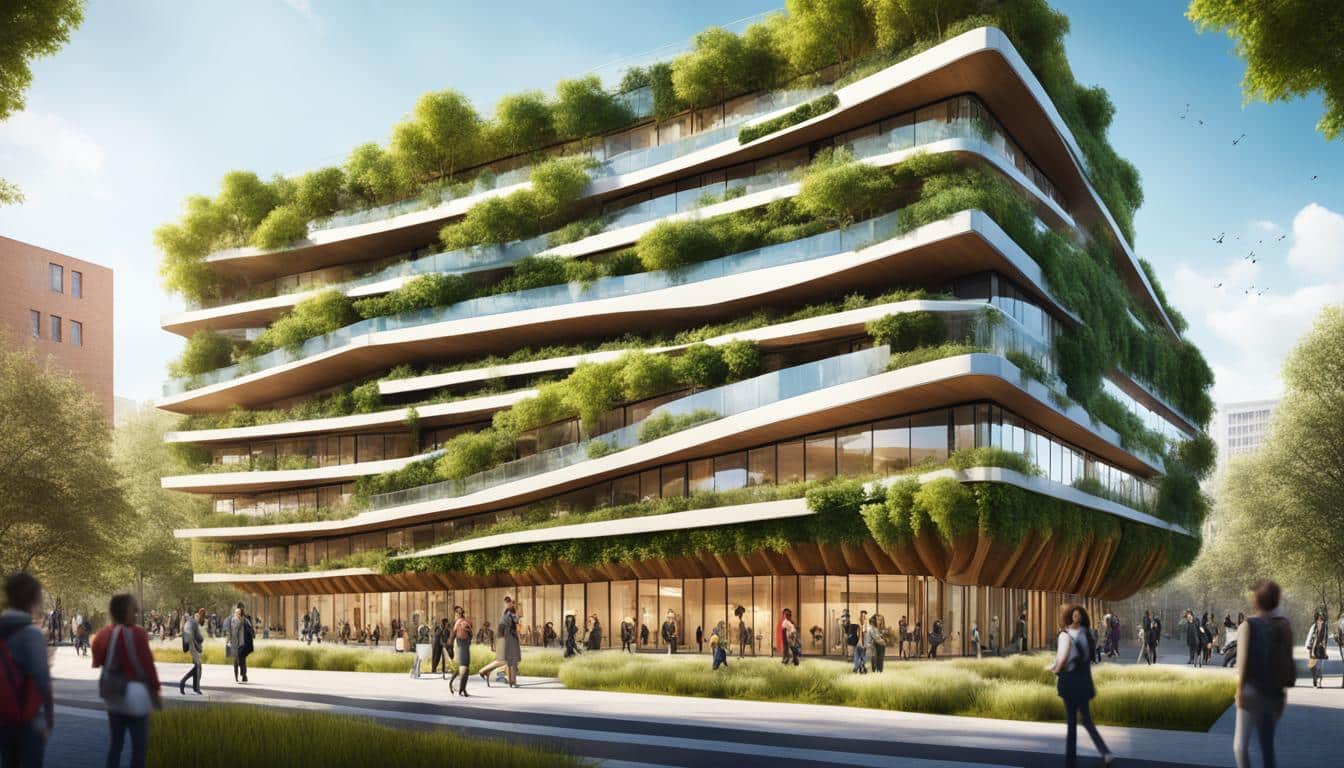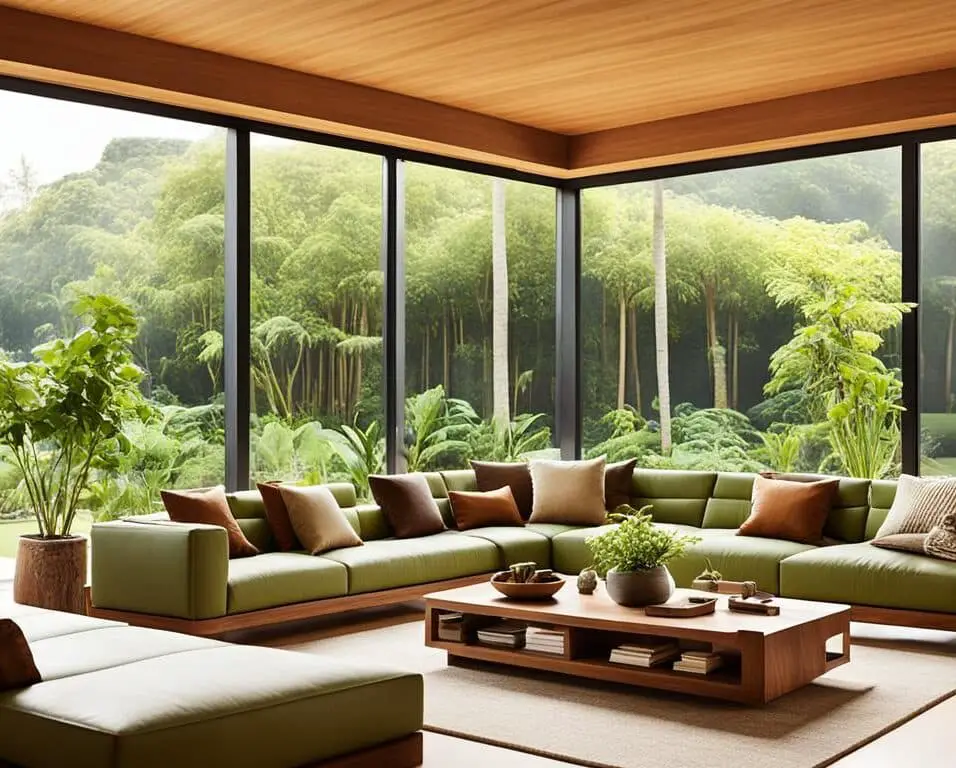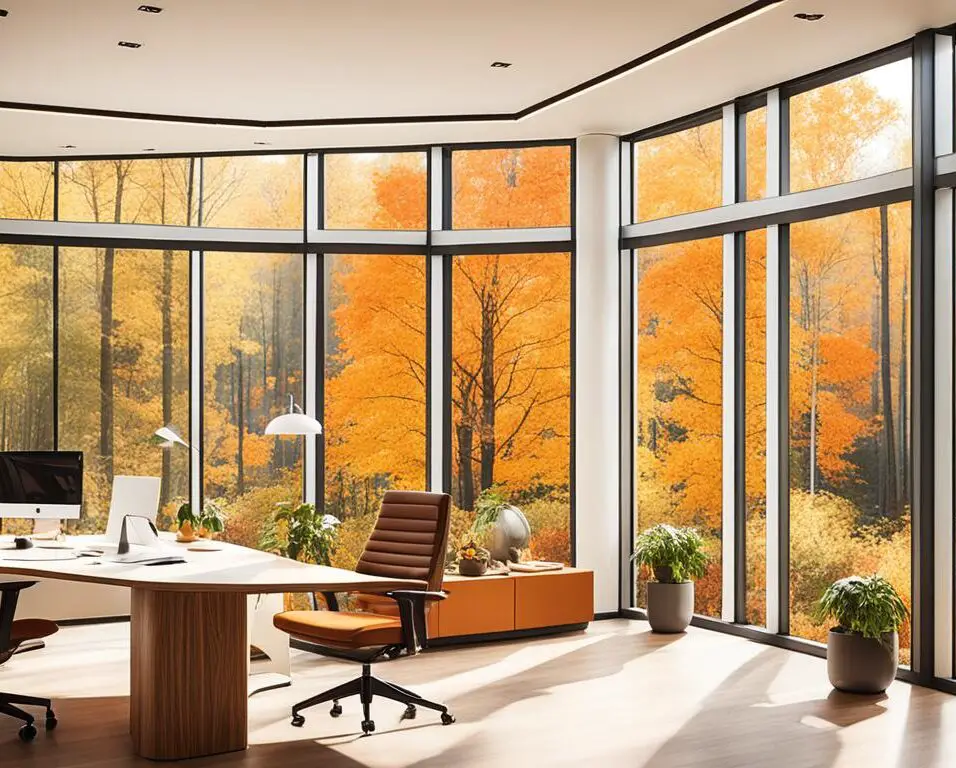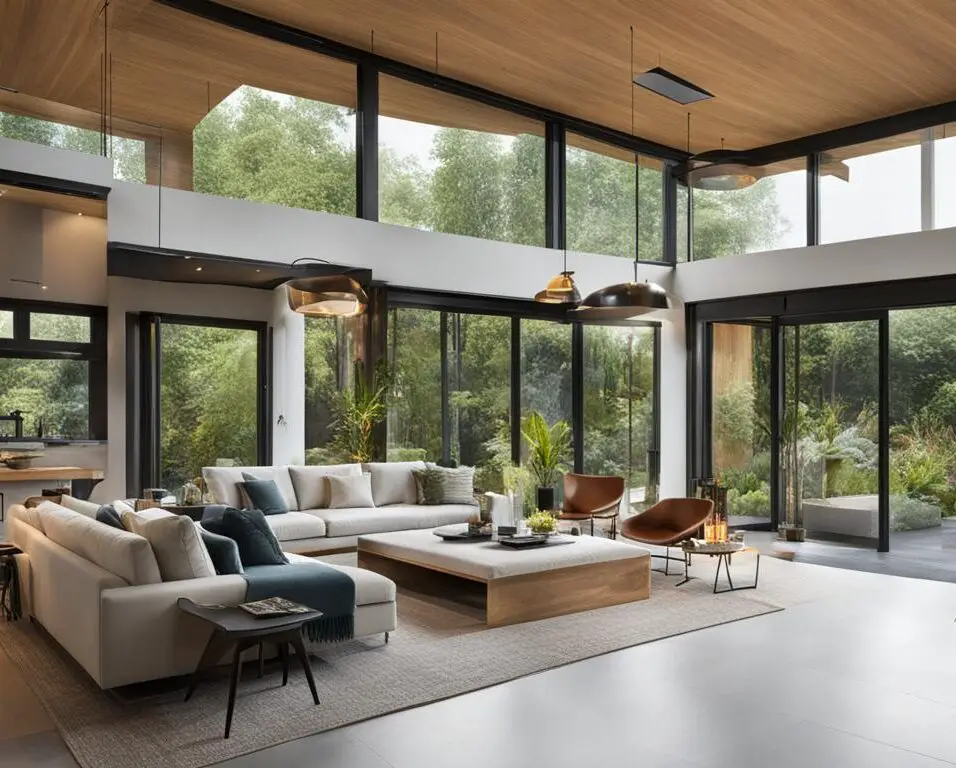Cultural Tapestry: The Influence of Culture in Biophilic Architecture
Biophilic architecture, with its focus on incorporating natural elements into design, is shaped by cultural influences in profound ways. Cultures around the world have unique perspectives on the relationship between humans and nature, leading to diverse approaches to biophilic design. From minimalism to indigenous influences and cultural symbolism, each culture adds its own flavor to the tapestry of biophilic architecture.
In this article, we will explore the significance of cultural influences in biophilic architecture, delving into how different cultures shape this design philosophy. By examining case studies and examples, we will uncover how cultural nuances infuse biophilic architecture with meaning, beauty, and a deep connection to our heritage.
Key Takeaways
- Cultural influences play a significant role in shaping biophilic architecture.
- Minimalism is a key element in biophilic architecture, reflecting cultural preferences for simplicity and functionality.
- Indigenous cultures bring a unique sense of place and heritage to biophilic design.
- Cultural symbolism adds depth and meaning to biophilic architecture, connecting people to their heritage.
- Global design perspectives in biophilic architecture celebrate the richness and diversity of cultures worldwide.
The Role of Minimalism in Biophilic Architecture
Minimalism plays a significant role in the design of biophilic architecture, creating a harmonious connection with nature. This design approach prioritizes clean lines, simplicity, and functionality, eliminating unnecessary embellishments to create spaces that reflect the beauty of the natural world. By embracing minimalism, biophilic architecture enhances the tranquility and balance of the environment.
Incorporating clean lines into biophilic architecture emphasizes simplicity and elegance, allowing organic elements to shine. The use of minimalistic elements in architectural design fosters a sense of calmness and clarity, allowing the focus to be on the natural world. By minimizing distractions and visual clutter, the simplicity of clean lines enhances the overall aesthetic appeal and creates a serene atmosphere.
Minimalism also reflects the cultural preferences of certain societies, such as Scandinavian and Japanese cultures. These cultures value minimalism and understated elegance, embracing simplicity as a way of life. Biophilic architecture influenced by these cultural preferences integrates clean lines and minimalist elements to create spaces that exude tranquility and balance.
“Simplicity is the ultimate sophistication.” – Leonardo da Vinci
The use of simple and functional design elements in biophilic architecture allows the focus to be on the natural world. By eliminating unnecessary embellishments, spaces can become a canvas for nature to unfold its beauty. The simplicity of clean lines creates an uncluttered and peaceful environment, enhancing the connection between humans and the natural world.
| Benefits of Minimalism in Biophilic Architecture | Examples of Minimalistic Design Elements in Biophilic Architecture |
|---|---|
|
|
Indigenous Cultural Influences in Biophilic Architecture
Indigenous cultures from around the world have an inherent understanding of the deep connection between humans and nature. This reverence for the natural world is deeply ingrained in their traditions and finds expression in their architecture. When it comes to biophilic architecture, indigenous cultural influences play a significant role, enriching the design with elements that reflect the local environment and traditional aesthetics.
“The indigenous cultures have a profound respect for the Earth and its resources. This respect is reflected in their architecture, which seeks to harmonize with nature and preserve the cultural heritage.”
Native American Architecture
Native American architecture showcases the profound respect and harmonious relationship with nature. Organic materials like wood, stone, and adobe are commonly used to create structures that blend seamlessly into their surroundings. Earthy colors inspired by the natural landscape, such as ochre, brown, and terracotta, are prominent in the design, invoking a sense of warmth and connection to the Earth.
Aboriginal Architecture in Australia
Aboriginal architecture in Australia embraces storytelling and a profound connection to the land. Traditional dwellings, such as bark huts and rock shelters, utilize natural materials found in the local environment. The use of bark as a building material and rock formations as natural foundations creates a sense of unity with the surrounding landscape. These architectural elements serve as a tangible link to the ancestral heritage and cultural traditions of the Aboriginal people.
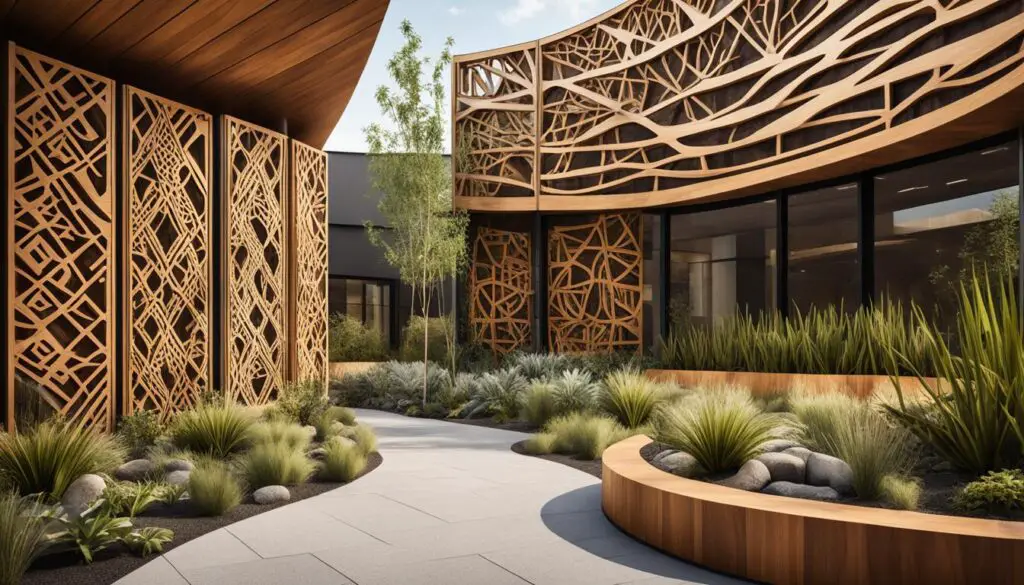
Cultural Significance and Heritage
The incorporation of indigenous cultural influences in biophilic architecture adds a unique sense of place and heritage to the design. It not only creates spaces that blend seamlessly with the natural environment but also honors the cultural traditions and values of the indigenous communities. By preserving and integrating their traditional aesthetics, biophilic architecture becomes a celebration of cultural diversity, showcasing the richness of indigenous cultures and their deep connection to nature.
| Indigenous Culture | Architectural Elements | Aesthetics |
|---|---|---|
| Native American | Organic materials, earthy colors | Harmonious, warm, grounded |
| Aboriginal (Australia) | Bark, rocks, storytelling | Ancestral, interconnected, natural |
Cultural Symbolism in Biophilic Architecture
Cultural symbolism plays a significant role in the realm of biophilic architecture. Designers draw inspiration from traditional motifs and symbols, incorporating them into the various elements of their designs. These cultural symbols not only add depth and meaning to the spaces but also create a sense of cultural identity and heritage for the people who interact with them.
For instance, in Chinese culture, the lotus flower is considered a symbol of purity and enlightenment. It is often incorporated as a symbolic element in biophilic designs, representing the connection between humans and nature. The lotus flower’s intricate beauty and serene presence evoke a sense of tranquility within architectural spaces.
| Symbol | Meaning |
|---|---|
| Lotus Flower | Symbolizes purity and enlightenment |
| Peacock | Symbolizes beauty and grace |
“The incorporation of cultural symbols in biophilic architecture not only enhances the aesthetic appeal but also serves as a reminder of our rich cultural heritage. These symbols have the power to transport us to a place of deep connection with nature and our roots.”
Similarly, in Indian culture, the peacock symbolizes beauty and grace. Biophilic architecture often incorporates the peacock motif into architectural elements, such as decorative screens or wall reliefs, to add a touch of cultural symbolism and create a visually engaging environment.
Cultural symbolism in biophilic architecture enables individuals to connect with their heritage and cultural values. It fosters a sense of belonging and pride, creating spaces that have a deeper significance beyond their functional aspects. By incorporating traditional motifs and symbols, biophilic designs become more than just structures; they become a reflection of the cultural fabric that makes us who we are.
Global Design Perspectives in Biophilic Architecture
Biophilic architecture draws inspiration from diverse global design perspectives, incorporating the unique aesthetics of different cultures. By embracing these global design influences, biophilic architecture transforms into a vibrant tapestry of multicultural design, celebrating the richness and diversity of our world’s cultures. Let’s explore two striking examples of how biophilic design is shaped by the aesthetics and principles of Scandinavian and African cultures.
Scandinavian Design: Simplicity, Minimalism, and Natural Materials
Scandinavian design has long been admired for its clean lines, minimalistic approach, and emphasis on natural materials. This design philosophy aligns perfectly with the principles of biophilic architecture, which seeks to create a connection with nature through design elements. Scandinavian-inspired biophilic architecture incorporates simple, uncluttered spaces, using neutral color palettes that evoke tranquility and balance. Natural materials, such as wood and stone, are featured prominently, bringing a sense of warmth and authenticity to the spaces.
“The key to Scandinavian design is the belief that simplicity and functionality can coexist harmoniously in a space. This philosophy resonates deeply with the principles of biophilic architecture, where the goal is to create spaces that enhance well-being by connecting people with the natural world.” – Arne Jacobsen, Danish architect and designer.
African Design: Vibrant Colors, Patterns, and Organic Shapes
African design is known for its bold use of colors, intricate patterns, and organic shapes. In biophilic architecture inspired by African design, vibrant hues inspired by landscapes and nature are used strategically to create an uplifting and energetic atmosphere. Patterns and textures found in African art and culture are incorporated into architectural elements, such as tiles, murals, and textiles. Organic shapes, reminiscent of natural forms like plants and animals, are integrated into the design, connecting the built environment with the surrounding natural world.
“African design is a vibrant expression of our connection to nature and our cultural heritage. Biophilic architecture allows us to bring these elements into our built environments, creating spaces that are not only beautiful but also deeply meaningful.” – Nkuli Mlangeni, South African architect.
By embracing global design perspectives, biophilic architecture becomes a powerful tool for cultural exchange and representation. It enhances the aesthetic appeal of architectural spaces, while also adding cultural significance and authenticity. Through the integration of elements from Scandinavian design and African design, biophilic architecture showcases the harmonious relationship between humans and nature across different cultures.
| Scandinavian Design | African Design |
|---|---|
| Emphasis on simplicity and minimalism | Bold use of vibrant colors |
| Incorporation of natural materials | Intricate patterns and organic shapes |
| Neutral color palettes for a sense of tranquility | Inspired by landscapes and nature |

Cultural Practices and Rituals in Biophilic Architecture
Cultural practices and rituals have a profound influence on the design and implementation of biophilic architecture. These practices reflect the deep connection between humans and the natural world, guiding architects and designers in creating spaces that foster a harmonious relationship with nature. Two examples of cultural practices that inspire biophilic design are Shinrin-yoku from Japanese culture and Vastu Shastra from Hindu culture.
Shinrin-yoku, also known as forest bathing, is a popular cultural practice in Japan that promotes the therapeutic benefits of immersing oneself in nature. Inspired by this practice, biophilic architecture incorporates elements like indoor gardens, natural light, and flowing water to create a soothing and rejuvenating environment. These elements mimic the serene atmosphere of a forest, inviting occupants to experience the healing power of nature within architectural spaces.
Vastu Shastra is an ancient Indian architectural tradition that emphasizes aligning buildings with the forces of nature. This practice guides the design of spaces to create a harmonious balance between the environment and the structure. Biophilic architecture influenced by Vastu Shastra integrates elements like natural light, open courtyards, and strategic placement of windows and doors to optimize energy flow and enhance occupants’ well-being.
“Cultural practices and rituals provide a framework for incorporating biophilic elements into architectural spaces, enhancing the connection between humans and nature.”
By incorporating cultural practices and rituals into biophilic architecture, designers can create environments that not only celebrate cultural heritage but also promote wellness and sustainability. These practices offer a framework for integrating biophilic elements, such as natural materials, vegetation, and daylight, into architectural spaces. As a result, occupants experience a deeper connection to nature, improved well-being, and a sense of cultural identity.
| Cultural Practice | Influence on Biophilic Architecture |
|---|---|
| Shinrin-yoku | Inspires the incorporation of indoor gardens, natural light, and flowing water to create a soothing and rejuvenating environment that mimics the therapeutic atmosphere of a forest. |
| Vastu Shastra | Guides the design of spaces to align with natural forces, optimizing energy flow and enhancing occupants’ well-being through elements like natural light and open courtyards. |
By embracing cultural practices and rituals, biophilic architecture becomes a gateway to connecting with nature and cultivating a sense of place and belonging. It is through this integration of cultural traditions that biophilic architecture truly thrives, making a significant impact on the well-being and cultural sustainability of individuals and communities.
Biophilic Architecture and Cultural Sustainability
In the realm of biophilic architecture, cultural sustainability plays a vital role in integrating traditional knowledge and practices into design. Across different cultures, architectural techniques and materials have evolved over generations to create structures that harmonize with the natural environment. By incorporating these traditional elements into biophilic architecture, we not only preserve cultural heritage but also establish sustainable and environmentally friendly spaces. This approach ensures that cultural traditions and practices are passed down to future generations, fostering a deep connection between individuals and the natural world.
One example of cultural sustainability in biophilic architecture is the preservation of traditional construction methods. In communities where biophilic design is deeply rooted, architects and designers strive to incorporate local craftsmanship and traditional building techniques. This integration not only honors cultural heritage but also promotes sustainable practices, as traditional methods often prioritize the use of natural and locally sourced materials.
Preserving Cultural Identity
A significant aspect of cultural sustainability in biophilic architecture is the preservation of cultural identity. By incorporating elements of traditional knowledge and aesthetics into design, architectural spaces become a celebration of cultural heritage. For instance, indigenous cultures often have a deep connection to nature, and their traditional practices and rituals offer valuable insights into sustainable and biophilic design.
“Integrating traditional knowledge and practices into biophilic architecture is not only about sustainable design, but also about preserving cultural identity and fostering a sense of belonging” – Architectural Digest
By respecting cultural traditions and incorporating them into architectural spaces, biophilic design creates a sense of place and helps communities maintain their cultural identity. Traditional knowledge surrounding the use of local materials, vernacular architecture, and symbiotic relationships with nature all play a crucial role in fostering cultural sustainability within the realm of biophilic design.
Case Study: The Southwestern Adobe Architecture
A prime example of cultural sustainability in biophilic architecture can be found in the Southwestern United States, where the adobe building style has been utilized for centuries. Adobe structures, made from a combination of sun-dried mud bricks, straw, and other natural materials, are not only energy-efficient but also blend seamlessly with the surrounding desert landscape. This architectural style not only stands as a testament to the cultural heritage of the region but also showcases the sustainable use of local resources.
| Key Features of Southwestern Adobe Architecture | Sustainable Benefits |
|---|---|
| Thick adobe walls provide thermal insulation | Reduces the need for heating and cooling, leading to energy efficiency |
| Integration of natural materials like straw and clay | Minimizes the use of synthetic and non-renewable materials |
| Flat roofs with overhangs for shade | Passively cools the interior, reducing reliance on mechanical cooling systems |
| Integration of courtyards and natural ventilation | Promotes airflow and natural cooling, reducing the need for artificial ventilation |
This case study exemplifies how cultural sustainability in biophilic architecture can contribute to a more resilient and environmentally conscious future.
Conclusion
Cultural influences are fundamental in shaping the world of biophilic architecture. From minimalism to indigenous cultural influences, cultural symbolism, and global design perspectives, each culture brings its unique perspective and aesthetic to the realm of biophilic design. By integrating cultural practices, rituals, and traditional knowledge, biophilic architecture becomes a celebration of cultural heritage while fostering a profound connection between people and the natural world. The influence of culture in biophilic architecture creates a diverse and vibrant tapestry of design that enhances the aesthetic appeal and cultural significance of architectural spaces.
FAQ
How does culture influence biophilic architecture?
Culture plays a significant role in shaping biophilic architecture. Different cultures have unique perspectives on the relationship between humans and nature, leading to diverse approaches to biophilic design. Cultural nuances influence elements such as minimalism, indigenous influences, cultural symbolism, global design perspectives, cultural practices and rituals, and cultural sustainability in biophilic architecture.
What is the role of minimalism in biophilic architecture?
Minimalism is a key element in biophilic architecture. Clean lines and simplicity create a connection to nature and reflect the cultural preferences of certain societies. Minimalist designs prioritize simplicity and functionality, eliminating unnecessary embellishments. The use of clean lines and minimalist elements enhances the natural harmony and tranquility of spaces.
How are indigenous cultures incorporated into biophilic architecture?
Indigenous cultures around the world have a deep connection to nature, which is reflected in their traditions and architecture. Biophilic architecture influenced by indigenous cultures often includes elements that reflect the local environment and traditional aesthetics. For example, Native American architecture incorporates organic materials and earthy colors, while Aboriginal architecture in Australia incorporates storytelling and the use of natural materials like bark and rocks.
How does cultural symbolism play a role in biophilic architecture?
Cultural symbolism plays a significant role in biophilic architecture by incorporating traditional motifs and symbols into the design elements. For example, in Chinese culture, the lotus flower represents purity and enlightenment and is often used symbolically in biophilic designs. Similarly, in Indian culture, the peacock symbolizes beauty and grace and is incorporated into architectural elements. These cultural symbols add depth and meaning to biophilic architecture, connecting people to their heritage and creating a sense of cultural identity.
How do global design perspectives influence biophilic architecture?
Biophilic architecture embraces diverse global design perspectives, reflecting the unique aesthetics of different cultures. For example, Scandinavian design emphasizes simplicity, minimalism, and natural materials, while African design incorporates vibrant colors, patterns, and organic shapes. By embracing these global design perspectives, biophilic architecture becomes a multicultural tapestry, celebrating the richness and diversity of cultures around the world.
How do cultural practices and rituals influence biophilic architecture?
Cultural practices and rituals guide the design and implementation of biophilic architecture. For example, in Japanese culture, the practice of Shinrin-yoku, or forest bathing, encourages immersion in nature for its therapeutic benefits. Biophilic architecture inspired by this cultural practice incorporates elements like indoor gardens, natural light, and flowing water to create a soothing and rejuvenating environment. Similarly, in Hindu culture, the practice of Vastu Shastra guides the design of buildings to align with natural forces.
How does biophilic architecture contribute to cultural sustainability?
Biophilic architecture embraces cultural sustainability by integrating traditional knowledge and practices into design. Traditional architectural techniques and materials have evolved over generations in many cultures to create structures that are in harmony with the natural environment. By incorporating these traditional elements into biophilic architecture, designers can preserve cultural heritage while creating sustainable and environmentally friendly spaces. Cultural sustainability in biophilic architecture ensures that cultural traditions and practices are passed down to future generations while fostering a deep connection to nature.
How does culture influence the overall impact of biophilic architecture?
Culture has a significant influence on biophilic architecture, shaping its elements and design choices. From minimalism to indigenous cultural influences, cultural symbolism, global design perspectives, cultural practices and rituals, and cultural sustainability, every culture brings its unique perspective and aesthetic to biophilic design. By integrating cultural traditions and practices, biophilic architecture becomes a celebration of cultural heritage while fostering a deep connection between people and the natural world.



